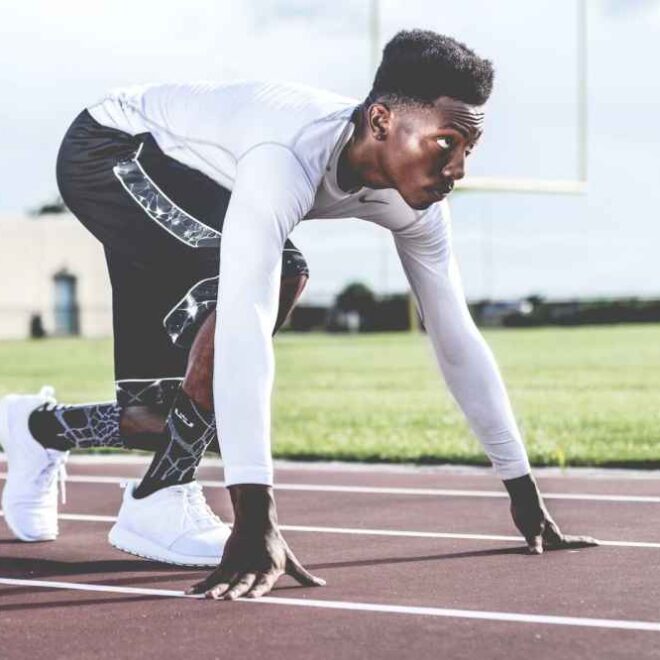Class: Primary 1
Term: 2nd Term
Week: 8
Age: 6 years
Duration: 45 minutes
Date:
Subject: Basic Science and Technology
Curriculum Theme: Basic Science
Topic: Movement
Content: Simple Athletics activities
SPECIFIC OBJECTIVES: At the end of the lesson, pupils should be able to:
- Explain Simple athletics
- State the safety rules in athletics.
- Demonstrate simple athletic activities.
Instructional Materials:
- Cones or markers: Use cones or markers to set up boundaries or markers for running, jumping, and throwing activities. They help define the space and provide visual cues for the students.
- Safety posters: Display safety posters or visuals that illustrate the safety rules in athletics. These posters can serve as visual reminders for the students to follow the safety guidelines during the activities.
- Soft balls or beanbags: Provide soft balls or beanbags for throwing activities. These materials are safer and easier for young students to handle as they practice their throwing skills.
- Picture books or videos: Utilize picture books or educational videos that showcase different athletic activities. This can help engage the students and provide visual reinforcement of the lesson content.
- Safety gear demonstration: If available, demonstrate and discuss the importance of safety gear such as helmets, knee pads, or elbow pads for specific athletic activities like biking or skating.
INSTRUCTIONAL PROCEDURES
Content Development: Simple Athletic activities
| Time | Content | Teaching Method | Teacher’s Points/Activities | Pupils’ Activities |
|---|---|---|---|---|
| 5 mins | Introduction | Discussion | – Greet the pupils & Recap previous lesson on movement – Explain the importance of safety rules in athletics | – Listen attentively & participate in the discussion. |
| 10 mins | Safety Rules in Athletics | Explanation | – Discuss and emphasize safety rules in athletics (e.g., warming up, wearing appropriate attire, avoiding dangerous areas) – Show examples and demonstrate correct behavior | – Listen attentively. – Ask questions regarding safety rules |
| 20 mins | Simple Athletic Activities | Practical Demonstration | – Teach and demonstrate simple athletic activities (e.g., running, jumping, throwing). – Break down each activity and show correct techniques. – Provide opportunities for pupils to practice each activity | – Observe and imitate teacher’s demonstration – Practice simple athletic activities – Ask questions when needed |
| 5 mins | Evaluation | Questioning | Ask questions to assess pupils’ understanding of safety rules and simple athletic activities | Respond to questions asked by the teacher |
| 5 mins | Note Copying | Writing | Provide pupils with the necessary notes on safety rules and simple athletic activities | Copy the notes into their notebooks |
Note:
Simple athletic activities
Simple Athletics activities involves various sports and games that require physical skills like running, jumping, and throwing.
Safety rules in athletics:
- Always warm up before starting any athletic activity.
- Wear appropriate attire, such as sports shoes and comfortable clothing.
- Follow the instructions and guidelines given by the teacher.
- Avoid dangerous areas or obstacles.
- Ask for help or clarification when needed.
Suggested Simple Athletic Activities (Practical Activity):
– Running: Practice running in a straight line with proper form.
– Jumping: Learn basic jumping techniques, such as long jump or high jump.
– Throwing: Practice throwing a ball or object with accuracy.
Evaluation Questions:
Ask the following questions to evaluate the lesson:
- Mention 3 safety rules in athletics?
- Mention 3 simple athletic activities we demonstrated?
Teacher’s Aide:
- Teaching Assistant: If available, assign a teaching assistant to help you with managing the class and providing individual assistance to students during the practical activities. The teaching assistant can support students who need extra guidance or reinforcement.
- Demonstrator: Enlist the help of a student or a volunteer to assist with demonstrating the athletic activities while you explain the instructions.
- Peer Mentors: Assign older or more experienced students as peer mentors to work with and guide their younger classmates during the practice activities.
- Safety Monitor: Appoint a student as a safety monitor whose role is to ensure that all students are following the safety rules during the athletic activities.
- Note Taker: Assign a responsible student to take notes during the lesson and share them with the class afterward.
- Equipment Manager: Delegate a student to be in charge of managing the equipment and ensuring it is organized and ready for use during the activities. This helps maintain an efficient flow of the lesson and prevents disruptions.
NOTE TO TEACHERS: Please note that the actual content of the lesson, teaching methods, and pupil activities may vary based on your specific teaching style, curriculum, or resources. Feel free to customize the lesson note to fit your needs.

